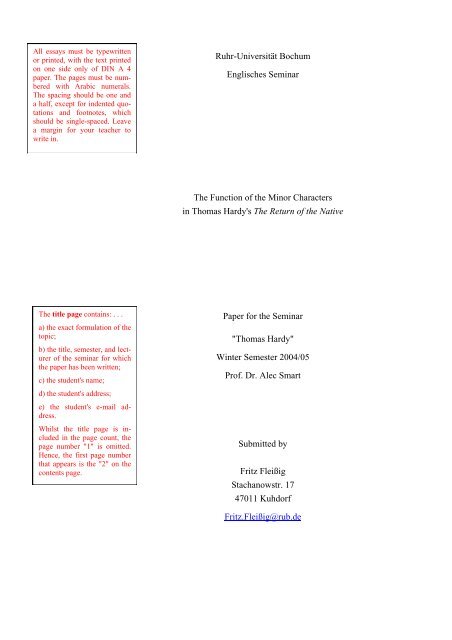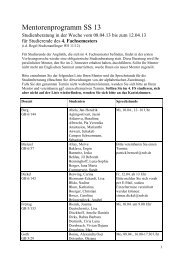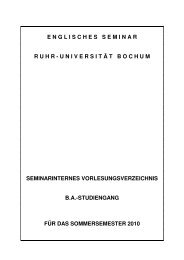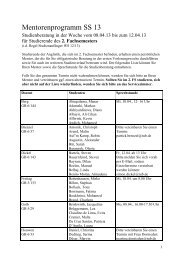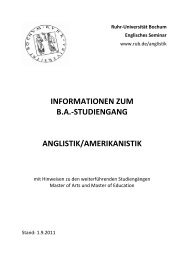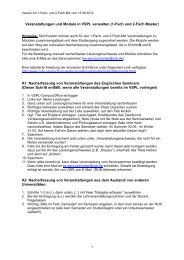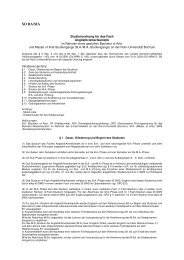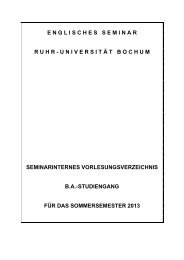Model Paper - Englisches Seminar - Ruhr-Universität Bochum
Model Paper - Englisches Seminar - Ruhr-Universität Bochum
Model Paper - Englisches Seminar - Ruhr-Universität Bochum
Create successful ePaper yourself
Turn your PDF publications into a flip-book with our unique Google optimized e-Paper software.
All essays must be typewritten<br />
or printed, with the text printed<br />
on one side only of DIN A 4<br />
paper. The pages must be numbered<br />
with Arabic numerals.<br />
The spacing should be one and<br />
a half, except for indented quotations<br />
and footnotes, which<br />
should be single-spaced. Leave<br />
a margin for your teacher to<br />
write in.<br />
The title page contains: . . .<br />
a) the exact formulation of the<br />
topic;<br />
b) the title, semester, and lecturer<br />
of the seminar for which<br />
the paper has been written;<br />
c) the student's name;<br />
d) the student's address;<br />
e) the student's e-mail address.<br />
Whilst the title page is included<br />
in the page count, the<br />
page number "1" is omitted.<br />
Hence, the first page number<br />
that appears is the "2" on the<br />
contents page.<br />
<strong>Ruhr</strong>-<strong>Universität</strong> <strong>Bochum</strong><br />
<strong>Englisches</strong> <strong>Seminar</strong><br />
The Function of the Minor Characters<br />
in Thomas Hardy's The Return of the Native<br />
<strong>Paper</strong> for the <strong>Seminar</strong><br />
"Thomas Hardy"<br />
Winter Semester 2004/05<br />
Prof. Dr. Alec Smart<br />
Submitted by<br />
Fritz Fleißig<br />
Stachanowstr. 17<br />
47011 Kuhdorf<br />
Fritz.Fleißig@rub.de
The table of contents<br />
appears on the second<br />
page. It describes the<br />
structure of the paper,<br />
indicating the page on<br />
which each section or<br />
subsection begins.<br />
Chapter headings must<br />
contain exactly the same<br />
wording as in the text<br />
proper.<br />
- 2 -<br />
Contents<br />
1. Introduction 3<br />
2. The Place of the Minor Characters in the Structure of the Novel 3<br />
2.1. Setting 3<br />
2.2. Characters 4<br />
2.3. Point of view 5<br />
2.4. Plot 5<br />
2.5. Theme 5<br />
2.5.1. Religion 5<br />
2.5.2. Superstition 5<br />
2.5.3. Education 5<br />
3. Conclusion 6<br />
Works Cited 7
Titles of independent<br />
publications, i.e. of books<br />
or journals, should be<br />
italicized. (Exceptions:<br />
the Koran, the Bible).<br />
A source must be acknowledged<br />
not only if it<br />
is quoted from directly but<br />
also if it is paraphrased.<br />
The use of a source must<br />
be documented immediately.<br />
Listing it in the<br />
bibliography or referring<br />
to it somewhere else in the<br />
paper is not enough.<br />
Since the bibliography<br />
contains a complete list of<br />
cited works, the author's<br />
name and the page numbers<br />
generally suffice to<br />
document a source in the<br />
main text of the paper (if<br />
possible, sources should<br />
not be indicated by footnotes).<br />
Footnotes are numbered<br />
consecutively throughout<br />
a paper. The existence of a<br />
footnote is indicated in the<br />
main text by a superscript<br />
Arabic numeral. The numerals<br />
should be placed<br />
immediately after the<br />
phrases containing the<br />
quoted material; they<br />
should follow, rather than<br />
precede, punctuation<br />
marks.<br />
Footnotes can be used<br />
for additional evidence<br />
which is relevant at a<br />
particular point in the<br />
paper but whose inclusion<br />
in the main text would<br />
interrupt the flow of the<br />
argument considerably.<br />
1. Introduction<br />
- 3 -<br />
Thomas Hardy's novels are all set in ''Wessex,'' a quasi-mythical region in<br />
southern and south-west England. The native community of this area was of<br />
particular interest to Hardy, and in The Return of the Native this community<br />
plays a greater role than it does in other works by Hardy.<br />
This paper will analyse the function of the rustics on the levels of setting,<br />
character, point of view, plot, and theme. It will be shown that, in The Return<br />
of the Native, the significance of the rustic characters is not limited to providing<br />
mere background scenery or local colour; instead, these characters fulfil<br />
various important functions such as commenting upon the main characters,<br />
offering an alternative to the intellectualised world of the main characters, and<br />
providing a form of comic relief.<br />
2. The Place of the Minor Characters in the Structure of the Novel<br />
2.1. Setting<br />
The Return of the Native is set on Egdon Heath, a vast area in Hardy's fictitious<br />
Wessex. All the twists and turns of the plot occur on the heath, which<br />
takes on the form of a closed microcosm of human existence. While some critics<br />
have claimed that the heath itself may be regarded as the major character<br />
(Fricker 228), the role of the heath people must not be neglected. The rustics<br />
set the stage on which the main characters enact their tragedy; and yet they are<br />
more than "bush[es] on legs." 1<br />
The natives' relationship to the heath has been a subject of Hardy scholarship<br />
for some time. While formerly critics claimed that the heath people live in<br />
harmony with nature (Holloway 48), more recent criticsm has come to<br />
acknowledge that this relationship is not very harmonious. Von Ziegesar, for<br />
instance, argues that the heath is ''doomed to decay'' from the very beginning<br />
of the novel (52).<br />
Indeed, there are several hints in The Return of the Native that the rustics'<br />
relationship to the heath is at best ambiguous. At the very beginning, after the<br />
lighting of the bonfires, the natives are set against the primeval natural powers<br />
of the heath, which are described as destructive:<br />
1 Hardy himself chooses this image: "Every individual was so involved in furze by his<br />
method of carrying the faggots that he appeared like a bush on legs till he had thrown<br />
them down" (65, emphasis added).
Quotations which cover<br />
more than three lines<br />
must be indented three to<br />
five spaces. The spacing is<br />
single; the quotation<br />
marks are omitted.<br />
Quotations must also be<br />
accompanied by a bibliographic<br />
reference that<br />
enables the reader to<br />
locate the passage in the<br />
original.<br />
Short quotations up<br />
to three lines are<br />
marked by double<br />
quotation marks.<br />
- 4 -<br />
It seemed as if the bonfire-makers were standing in some radiant upper<br />
storey of the world, detached from and independent of the dark stretches<br />
below. The heath down there was now a vast abyss and no longer a<br />
continuation of what they stood on; for their eyes, adapted to the blaze,<br />
could see nothing of the deep beyond its influence. (66)<br />
The fire in this context alienates the rustics from their native soil; they do not<br />
seem to be part of the heath any longer. [ . . . ]<br />
A similar description of the heath is to be found later on in the novel when<br />
Mrs Yeobright and Olly Dowden make for the town:<br />
Down, downward they went, and yet further down – their descent at<br />
each step seeming to outmeasure their advance. Their skirts were<br />
scratched noisily by the furze, their shoulders brushed by the ferns,<br />
which, though dead and dry, stood erect as when alive, no sufficient<br />
winter weather having as yet arrived to beat them down. (86)<br />
This descent from the heath back into town resembles a descent into hell (Paterson<br />
216). Here again the heath appears in opposition to civilization.<br />
[ . . . ]<br />
The rustics have come to accept the limitations the heath imposes upon<br />
them. The main characters, on the other hand, struggle to reform the living<br />
conditions of the rural community. Yet despite their best efforts they fail, as<br />
the example of Clym shows. The main characters' failed attempts at reform can<br />
be interpreted as Hardy taking sides with what has been termed ''the old world''<br />
of the natives (Grimsditch 87). However much Hardy might sympathise with<br />
this "old world," which resists the infiltration of modernity as best it can, he is<br />
also aware that this world cannot last. At a closer look, we can see that the<br />
rural world is already on its way to modernisation.<br />
2.2. Characters<br />
[ . . . ] More than anything else, the rustics stand for continuity and the preservation<br />
of custom. Although it has been convincingly shown that Hardy did not<br />
idealise the rural world against Clym's ''new world'' ideas of social and educational<br />
reform (von Ziegesar 52), the stability of the rustic community is certainly<br />
an indicator of the fragility of modern society. Compared to the rustics, the<br />
modern characters seem like a critical and endangered species (Fricker 232). [ .<br />
. . ]
Single quotation<br />
marks ('...') indicate<br />
a quotation within a<br />
quotation.<br />
If one wishes to omit a<br />
passage from the middle<br />
of a quotation, one<br />
must indicate this by<br />
[...], i.e. an ellipsis<br />
which is placed in<br />
square brackets to<br />
signal that it is not in<br />
the original.<br />
The quotation is from<br />
the same source as the<br />
previous one, only from<br />
a different page. If the<br />
quotation is from the<br />
same source AND the<br />
same page, you write<br />
only ibid.<br />
- 5 -<br />
From an ethical point of view, the rustics represent ''a still more limited and<br />
earlier stage of moral and intellectual evolution. They represent older, less<br />
conscious forms of fear and aspiration'' (Hyman 79). Being less conscious, the<br />
rustic characters are more comical than their modern counterparts. Thus they<br />
provide a much-needed comic ''relief to the sad 'twilight' tinge'' of the major<br />
characters (Grimsditch 75). [ . . . ]<br />
2.3. Point of view [ . . . ]<br />
2.4. Plot [ . . . ]<br />
2.5. Theme [ . . . ]<br />
2.5.1. Religion<br />
At first sight, the rustic community appears to be religious in a traditional<br />
Christian way. At a closer look, however, it becomes obvious that ''Christianity<br />
has cast only a veneer'' over the community's ancient, superstitious beliefs<br />
(Grimsditch 74). With the exception of a few characters (such as Humphrey),<br />
the rustics are still ''pagans at heart [...], unmoved by any deep belief in Christian<br />
theology'' (ibid. 90). [ . . . ]<br />
2.5.2. Superstition [ . . . ]<br />
2.5.3. Education [ . . . ]
3. Conclusion<br />
- 6 -<br />
As we have seen, the minor characters are given considerable space by Hardy<br />
because they fulfil a number of important functions: as contrasting characters,<br />
they direct the readers' attention to the value system held by the major characters;<br />
as a kind of epic equivalent to a ''chorus,'' they comment upon and challenge<br />
this system; as a community, they provide comic relief from the tragedy<br />
that permeates the lives of the main characters. The rustics' constant presence<br />
does not only lend the novel a regional touch (Butler 56); it also provides the<br />
reader with an insight into the mind of (nineteenth-century) rural man. It<br />
shows how, during the period of industrialisation, rural communities coped<br />
with various challenges to their established worldview, suggesting that the<br />
rustics' down-to-earth view of life represents, in the final instance, a valid alternative<br />
to the morally and emotionally stunted world of modern man.
For a book, give the<br />
author's name, the title<br />
in italics, place, publisher<br />
and year of publication.<br />
Follow the examples<br />
listed here in the<br />
use of punctuation<br />
marks.<br />
For articles in collections,<br />
give first the title<br />
of the article, then the<br />
title of the collection.<br />
(For further details see<br />
below under journal<br />
article).<br />
In English titles, capitalise<br />
all words except<br />
articles, prepositions,<br />
and the following<br />
words: and, or, to; always<br />
capitalise the last<br />
word.<br />
A journal article requires<br />
the following<br />
information:<br />
author of the article;<br />
title of the article in<br />
double quotation<br />
marks<br />
book titles within<br />
article titles are italicised;<br />
journal title in italics;<br />
volume number;<br />
year of publication in<br />
round brackets;<br />
page numbers.<br />
Title and subtitle of<br />
book, separated by a<br />
colon, in italics.<br />
Place of publication,<br />
publisher, and date of<br />
publication; if impossible<br />
to ascertain, add<br />
"n.p." (no place of publication<br />
given), "n.p."<br />
(no publisher given; this<br />
is no mistake: the two<br />
abbreviations are indeed<br />
identical), or "n.d." (no<br />
date of publication given).<br />
If more than one<br />
place is given, list only<br />
the first.<br />
- 7 -<br />
An academic paper<br />
must contain a bibliography,<br />
i.e. a list of all<br />
Works Cited<br />
the sources that have<br />
been used. It is placed at<br />
the end of the paper.<br />
Butler, Lance St. John. Thomas Hardy. Cambridge: CUP, 1978.<br />
Fricker, Robert. "Hardy: The Return of the Native." Der englische Roman: Von<br />
den Anfängen bis zur Gegenwart. 2 vols. Ed. Franz K. Stanzel. Düsseldorf:<br />
Bagel, 1969. 2: 215-50.<br />
Goetsch, Paul. Hardys Wessex-Romane. Tübingen: Narr, 1994.<br />
Grimsditch, Herbert B. Character and Environment in the Novels of Thomas<br />
Hardy. New York: Russell, 1962.<br />
Hardy, Thomas. The Return of the Native. Harmondsworth: Penguin, 1985.<br />
Hyman, Virginia R. Ethical Perspective in the Novels of Thomas Hardy. Port<br />
Washington, WI: Kennikat, 1975.<br />
Paterson, John. "The 'Poetics' of The Return of the Native." Modern Fiction<br />
Studies 6 (1960): 214-22.<br />
Ziegesar, Detlef von. Romananfänge und Romanschlüsse bei Thomas Hardy:<br />
Versuch einer formorientierten Interpretation. Göppingen: Kümmerle,<br />
1971.
Honesty Declaration<br />
- 8 -<br />
I hereby declare that the work submitted is my own and that all passages and<br />
ideas that are not mine have been fully and properly acknowledged.<br />
I am aware that I will fail the entire course should I include passages and ideas<br />
from other sources and present them as if they were my own.<br />
---------------------------- -----------------------<br />
Signature Date


